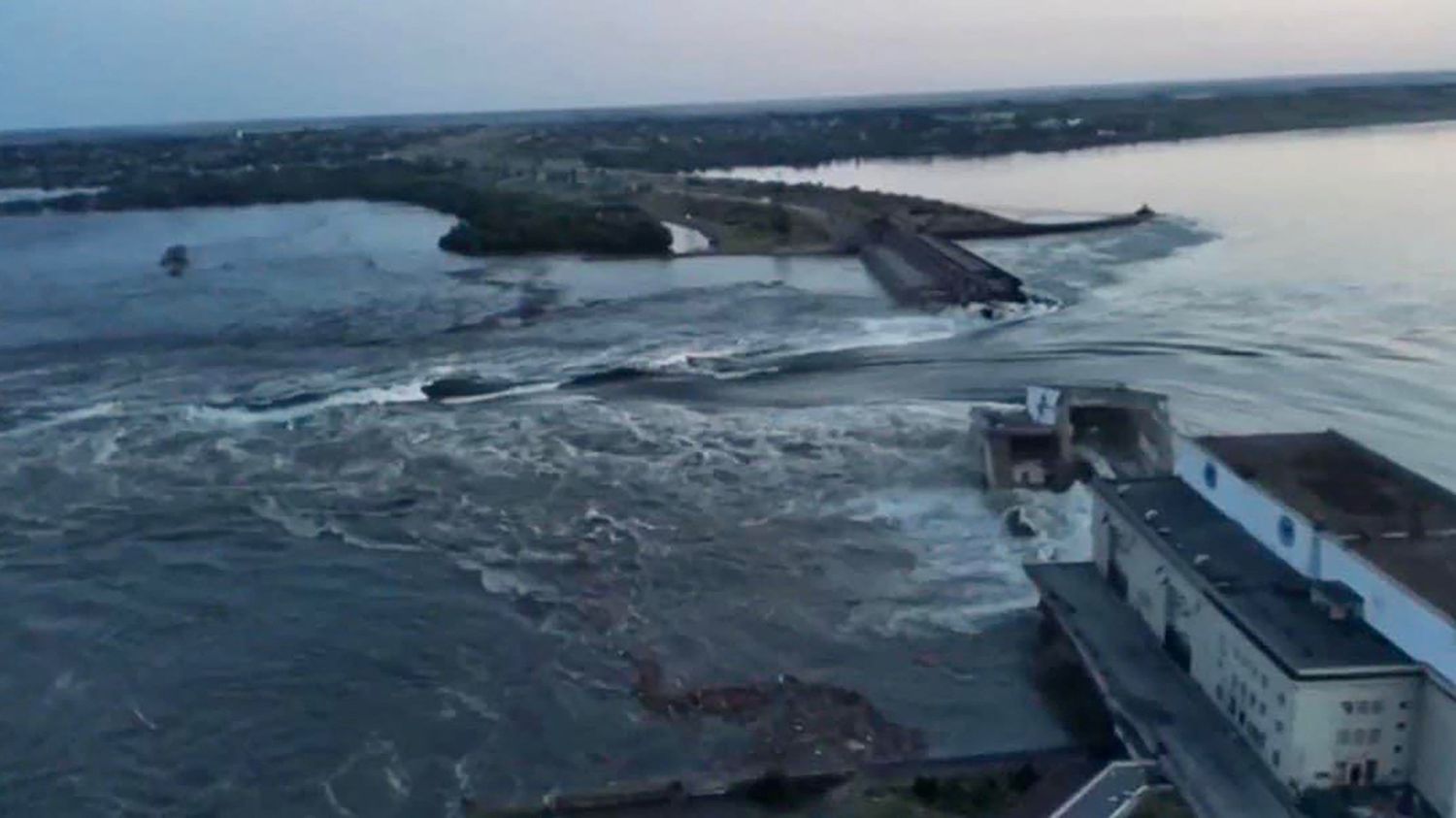kyiv claims that an explosion caused a breach in this strategic work, which was under Russian control. Evacuations have begun.
In the litany of damage caused by the Russian invasion in Ukraine, these could have particularly serious consequences: the Kakhovka hydroelectric dam, some 80 kilometers from Kherson, was partially destroyed, the Ukrainian presidency said on Tuesday June 6 and the occupation authorities installed by Russia in this southern region.
>> Follow the news of the war and the consequences of this destruction in our direct.
kyiv denounces a “war crime” of the Russian army. Dozens of localities downstream are threatened with flooding, and Ukraine has announced evacuations. Franceinfo summarizes what we know about the situation.
A breach is opened in the dam
While Ukraine claims the dam was damaged by an explosion, no footage of it has emerged. On the other hand, several videos attest to the extent of the damage. Starting with the one posted on Twitter by Ukrainian President Volodymyr Zelensky, obviously shot by a drone at dawn.
We see a breach on a large part of the dam itself, but also buildings of the Kakhovka hydroelectric power station, also damaged and partly immersed in water. They also appear on videos relayed on Russian Telegram channels and then on Twitter. Ukrhydroenergo, the Ukrainian dam management company, mentions in a press release a detonation “from inside the engine room”.
Ukraine accuses Russia, which controls the building
Volodymyr Zelensky attributed the destruction of the dam to “Russian terrorists”accusing Moscow of “war crime”. His adviser Mykhaïlo Podoliak affirms that Russia has “blew up” the work for “to create obstacles for the offensive actions of the armed forces” Ukrainian, when a counter-offensive is announced.
Located on the eastern bank of the Dnieper, Ukraine’s largest river, the Kakhovka power plant and its dam remained under Russian control, even after the Ukrainian army took over the western bank in November. In October, during a meeting of the Council of Europe, Volodymyr Zelensky reported having information according to which the Russian occupants had mined the building.
If the Kremlin has not reacted for the time being, the mayor installed by Russia in Nova Kakhovka, the city where the building is located, is advancing another version. According to Vladimir Leontiev, “multiple strikes targeted the dam” during the night and destroyed the gate valves of the dam, causing a “uncontrollable jet of water”. Statements that seem contradicted by the extent of the destruction observable in the images, which also extend to the plant itself.
The dam had already suffered damage, the origin of which is unknown: the comparison between satellite images from the Maxar network taken on May 28 and June 5 shows in particular that a road was destroyed in the meantime.
Flood threatens dozens of towns, evacuations
The Kakhovka dam, one of the largest in the country, regulates the flow of its main river, the Dnieper, upstream from the Kherson region. Its destruction threatens the territories downstream with a potentially destructive rise in water.
According to the Prime Minister of Ukraine, Denys Chmyhal, 80 localities risk being flooded. On the shore controlled by Ukraine, “about 16,000 people are in the critical zone”, warned the head of the local military administration, Oleksandr Prokudin. Of the Evacuation operations began Tuesday morning. Meeting on Tuesday morning, the Ukrainian national security council also ordered the supply of drinking water to the populations who were supplied by the reservoir.
On the Russian side, the head of the occupation government, Andrei Alekseïenko, assures that the big cities will be spared, but mentions 14 localities threatened by the rising waters, where reside “more than 22,000 people”. He does not present the evacuation as a necessity. Residents of 300 homes in Nova Kakhovka were however sheltered, according to the mayor. Images from the authorities and the Russian agency Ria Novosti show the extent of the rising waters in this municipality.
By opening an investigation for “ecocide”, the General Prosecutor’s Office of Ukraine also underlined the environmental consequences of the destruction of this dam. According to Kyiv, “150 tons of engine oil” were dumped into the Dnieper River.
Questions about the risk for the Zaporizhia power plant
The Zaporijjia nuclear power plant, located 150 km northeast of Kakhovka, uses the water retained by the dam to cool its fuel. Its destruction therefore raises fears of a drop in the level upstream, which would pose a new threat to the security of the site. The danger “now increasing rapidly”warns Mykhaïlo Podoliak, the adviser to the Ukrainian presidency.
But the International Atomic Energy Agency (IAEA), which has experts on site, estimated Tuesday morning that there was no “no immediate nuclear danger”. The director of the plant occupied by the Russian army, Yuri Tchernitchouk, is also reassuring: the cooling system can be powered by “several alternative sources”, he assures on Telegram. The site’s six reactors are shut down, “Cold” for five of them, “hot” for the latter, he added. For the IAEA, the cooling pond “will be enough to supply the plant with water for months”without ruling out a longer-term risk.
